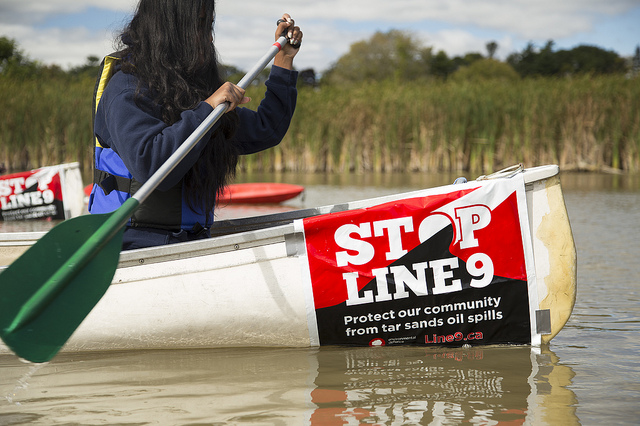Like this article? rabble is reader-supported journalism. Chip in to keep stories like these coming.
The Chippewas of the Thames First Nation (COTTFN) is seriously considering filing for an immediate injunction against Enbridge’s Line 9.
The injunction would force Enbridge to cease the flow of Line 9 — currently pumping up to 300,000 barrels a day of diluted tar sands bitumen through the First Nation’s territory — at least until COTTFN’s appeal to the initial ruling is heard by Supreme Court.
“We feel it’s wrong,” Myeengun Henry of the Chippewas of the Thames First Nation explains, “that their legal costs are being paid by the profits they’re making on a line that’s operating right now. We don’t think they should be operating while we’re in litigation.
“If there’s a way we can put an injunction on that line today, and stop them from having this terrible oil flow through out territory: that’s what we’re looking for right now,” Henry told rabble.
The Supreme Court of Canada announced last month that it will hear the First Nation’s case, which challenges the 2014 decision by the National Energy Board (NEB) to allow Enbridge to reverse the flow of Line 9.
Enbridge has previously stated its commitment “to fostering a strengthened relationship with the COTTFN.”
COTTFN maintains that the Canadian government neglected its constitutional duty, enshrined in section 35 of the Canadian Constitution, when it passed off approval of Line 9 to the NEB.
“We’re looking at legal opportunities with our lawyers right now and will know more later,” said Henry.
Risky business
Built in 1975 with an original lifespan of only 40 years, Line 9 represents a serious risk to the COTTFN’s land and sovereignty. The COTTFN has good reason to fear that within a year and a half there will be a break in the pipeline
It wouldn’t be the first for Enbridge. In fact, according to a study by the Polaris Institute using Enbridge’s own data, 804 spills occured on Enbridge pipelines between 1999 and 2010. The worst occured in 2010 near Marshall, Michigan and resulted in the release of more than 1,000,000 gallons of tar sands crude into the Talmadge Creek leading to the Kalamazoo River. Other spills have been reported since then, notably in 2013 in both Alberta and Michigan.
Tar sands oil, diluted with lighter petroleum products that allow it to flow through pipelines, has been shown to devastate ecosystems when spilled. COTTFN are very familiar with this story.
The colonial context of Line 9
When the pipeline was built in 1975, Henry explains, COTTFN were in the throws of residential schooling. “It was never in their interest to inform us,” he says. At the time, it was standard practice for the Canadian government to run slipshod over Indigenous rights in the interests of big business, industrial development and resource extraction.
Not much seems to have changed since then, if the government’s approach to Line 9 is to be any example.
A victory at the supreme court, however, could change that. The case will be heard in conjunction with a challenge by the people of Clyde River, Nunavut to the NEB for its approval of a five-year seismic blasting contract that would disrupt the community’s traditional way of life and subsistence practices. A win for these communities could set an important precedent for both Indigenous sovereignty and the climate justice movement.
“The residual effects of this decision would really affect how the NEB and proponents work with First Nations,” Henry explains. “We’re looking at this as a very historical legal case that will affect Kinder Morgan and Energy East and all the other pipelines throughout Canada, because they all travel through aboriginal traditional territories. This isn’t just a First Nations issue. It’s an issue that effects everybody.”
The case for climate justice
Critics warn that pipelines like Line 9 and Energy East clearly facilitate tar sands production at a time when the government should be putting strict limits on its extraction.
The International Energy Agency, for example, in its Energy Policies of IEA Countries Canada 2015 Review, warns that Canada is “not on track to meet its emissions reduction goals.” A big part of the problem is that the oil and gas sectors — especially tar sands extraction and fracking — together form “Canada’s largest contribution to greenhouse gas emissions.”
As John Sharkey of the Toronto No Line 9 Network points out, “we get all the risks, and oil companies get all the benefits,” referring to the “double jeopardy” of oil spills and greenhouse gas emissions. “Our job is to let them know they do not have social license for these pipelines.”
His group supports communities like COTTFN in their fight for sovereignty and environmental justice. At a time when governments need to push hard to reduce global emissions, to avoid catastrophic warming that is already causing sea levels to rise, food prices to sky rocket and extreme weather events to wreak havoc on communities, the lessons here couldn’t be clearer.
“Indigenous people around the world have to be the front runners on climate change,” Henry says, “because we’re the ones still on the land, hunting, fishing, and caring for the land as our mother, the earth.”
COTTFN needs to raise about half a million dollars for legal costs in this case. For more information on the Chippewas of the Thames First Nation’s struggle, and to contribute to their legal fund, visit here and donate here.
Keith Scott is a writer, activist and musician from Montreal, QC.
Photo: flickr/Environmental Defence Canada



